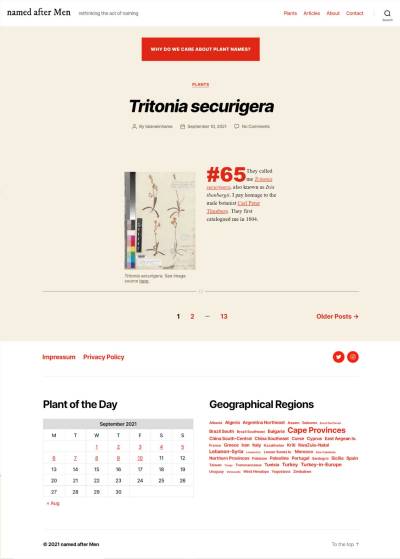Description
In biology it is common to name new species after human names, which are called patronyms. Once a new species' description is accepted, this name can rarely be changed. A species of beetle, Anophthalmus hitleri, was named after Adolf Hitler in 1933, and the name has not been changed even after World War II.
Modern biology as a scientific practice has an intricate relationship with colonial structures. Using the botanical naming system as an example this project aims to reveal this connection. Instead of taking morphological, contextual, or local cultural aspects into consideration while naming a new species, many scientists have chosen to name their “discoveries” after relatives, donors, or themselves. This personal, even emotional, practice goes against the claims for objectivity, impartiality, and neutrality in the sciences.
On the „naM“ website, everyday you get to know one plant that received a male name. Our goal is to rethink the power structures present in the practice of naming.
Dataset
Sources
Trefle.io – Botanical API
The Trefle API aims to deliver all plants informations under an accessible interface.
Documentation: https://docs.trefle.io/docs/guides/getting-started
Wikipedia Python API
Search Wikipedia, get article summaries, get data like links and images from a page, and more. Wikipedia wraps the MediaWiki API so you can focus on using Wikipedia data, not getting it.
Documentation: https://wikipedia.readthedocs.io/en/latest/code.html#api
Pykew - Royal Botanic Garden Kew API library
Library for easy access to Kew's nomenclatural and taxonomic services. Hides the intricacies of using the HTTP API.
Documentation: https://github.com/RBGKew/pykew
Strategy
1. Find all plants in Trefle.io having scientific names or synonyms ending with “ii”, together with the bibliography where they appear, the year they were first catalogued, their common names (not always available), and a link to a picture (not always available);
2. Extract the root of each word ending with “ii”, which corresponds to the name of the honored male person;
3. Use the following Wikipedia pages to build a dataset of botanists:
a. List of Botanists: https://en.wikipedia.org/wiki/List_of_botanists\\ b. List of Botanists by Author Abreviation: https://en.wikipedia.org/wiki/List_of_botanists_by_author_abbreviation_(A)\\
4. Use the following Wikipedia page to build a dataset of female botanists:
a. List of Women Botanists: https://en.wikipedia.org/wiki/List_of_women_botanists\\
5. Exclude female botanists from the list of botanists; 6. Double check manually excluding “female names” and botanists names, for which no information was found on the English written internet (mostly names that are not common in European countries); 7. Join plants dataset (from Trefle.io) with male botanists’ dataset (from Wikipedia) according to names derived from plants and last name of botanists. 8. Select only unique plants that have picture and for which at least one possible botanist name was found on Wikipedia. 9. Search for plant distribution in the Kew API. Extend the dataset with information about where the plants are native to. 10. For the 20 plants for which no distribution information was found, manually search for information on the internet.
Result
A dataset of 1026 unique plants that were named after men (scientific name or synonym). Some of the plants were named after more than one man in their cataloguing history. Some names point to more than one botanist (Brown, i.g.). There is no guarantee that these men are the people the plants are named after, given that one can honor any person by naming a plant (relative, sponsor, famous personality, or even a fictional character).
Daily posts bot
As part of this project, I programmed a bot that posts everyday a plant named after a male botanist on the project's website and on my Twitter profile. The code is available on Github.
Queries and formats content from a Postgresql database and posts it on Twitter and on a Wordpress blog. If the code throws any exception, the maintainer is notified per email.
Website
Project website: www.namedaftermen.com

